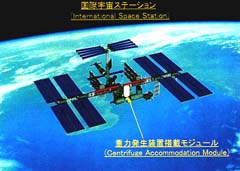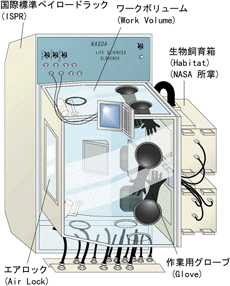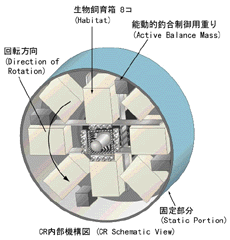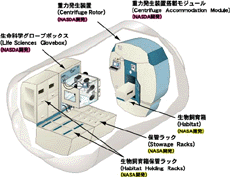|


((c):NASA) | | |
The Centrifuge is a laboratory for conducting gravitational biology
research in the International Space Station (ISS) program. The Centrifuge
consists of the Life Sciences Glovebox (LSG), Centrifuge Rotor (CR),
and Centrifuge Accommodation Module (CAM). LSG is to be delivered
on orbit in 2004, and CR/CAM, in 2006, by a U.S. Space Shuttle.
In this project, JAXA provides the Centrifuge to NASA as part of
the offset of NASA's provision of the Shuttle launch services for
the launch of the Japanese Experimental Module (Kibo).
|
The Centrifuge is a laboratory for studying
gravitational biology. It is used to precisely and quantitatively investigate
how microgravity affects biological specimens. The goal of this development project
is to test and demonstrate the operability to handle biological specimens in a
manned space environment, technology for a large rotating payload, and integration
of payloads into a module.
 | Outlines
of LSG/CR/CAM | |
Life Sciences Glovebox (LSG)
| The LSG provides an enclosed
environment (workvolume) in which biological specimens and chemicals are isolated
from the pressurized environment of the module and crew members can manipulate
those specimens through gloves. The LSG is the largest (500-liter) biological
experiment equipment used on orbit to date and can accommodate two habitats. Two
crew members can conduct science procedures at the same time, such as dissecting
small animals, and seeding and harvesting plants. | |
| | Launch
Date | Sep. 2004 (Utilization Flight 3:UF-3) | | Location | USLab
and CAM | | Mass | Less than 680kg | | Volume | One
ISPR rack size (Launch configuration) | | Operational Period | 10
years on orbit | | Habitat |
| Max. mass: | 116kg |
| Dimensions: | W48XH71XD61(cm)
W19XH28XD24(inch) | | Max number: | 2 |
| | Crew Operability | Two crew members can work
at the same time. | | Work Volume |
| Volume: | 0.5m3 |
| Temperature: | 18-27 Centigrade(Precision:
Less than 1 Centigrade) | | Equipment | Vacuum
Cleaner
Video Monitor
Video Camera(2)
Illumination | |
|  |
|
Centrifuge Rotor (CR)
| The CR is the largest (2.5m diameter) equipment for gravitational experiments.
It provides a selectable, simulated gravity environment from 0.01g up to 2.00g
(0.01g increments) for biological specimens on ISS. Small animals and plants could
also be used in experiments with the CR, and significant advances for those gravitational
experiments are expected. | | |
| Launch Date | Apr. 2006 (Utilization Flight 7:UF-7) |
| Location | CAM | | Mass | Less than 1875kg |
| Dimension | Rotating radius 1.25m | | Operational
Period | 10 years on orbit | | Habitat |
| Max.
mass: | 87kg | | Dimensions: | W19XH24.4XD24(inch)
W48XH62XD61(cm) | | Max number: | 8 |
| | Mission Overview | CR provides Biological specimens
with a simulated Gravitational environment by rotating habitats. |
| Rotor Functionality |
| Artificial Gravity: | 0.01-2.00g(0.01g
increments) | | Spin-up Acceleration: | 5min.-1hour |
| |  |
|
Centrifuge Accommodation Module (CAM)
| The CAM is a pressurized module specifically used for life science
research. It is equipped with the LSG, CR, habitat holding racks, a freezer rack,
and stowage racks. | | |
| Launch Date | Apr. 2006 (Utilization Flight 7:UF-7) |
| Mass | 10 tons | | Scale | Outer Radius:4.4m, Length:
8.98m | | Electric Power | 6.25kw x 2 strings, 120Vdc |
| Operational Period | 10 years on orbit | | Number
of racks | 14 racks (excluding CR) | | System racks | System
components Installed on the module wall | | Stowage racks | 10
racks | | Other racks | Habitat Holding Rack(2), Freezer
rack(1),LSG rack(1), CR(4-rack volume) | |  |
The Centrifuge's main mission
is to quantitatively
investigate how gravity affects hematology, immunology,
neuroscience, plant physiology, radiobiology, etc. Some of the experiments on
gravitational biology currently planned are;
- Evaluation of the
kinematics of plant orientation in microgravity and response to artificial gravity
- Effect of microgravity on skeletal growth, maturity, and calcium metabolism
- Examination of the effect of microgravity on blood and bone marrow colony
forming cells
- Muscle loss in rats in microgravity
- Role of gravity in lignification
and silicification
- Role of gravity in secondary metabolite production
The LSG development explores
techniques for isolating biological specimens from the crew, biological compatibility,
and crew operability in a pressurized module. Several functions are to be provided,
such as providing electrical power and air for biospecimens, to accumulate and
transfer data signals and video signals both for crew members on orbit and researchers
on Earth to monitor the status of the specimens.
The CR development involves
the challenge of "Slip Ring Technology" that bridges the rotating portion
and the static portion of the CR. It supplies air, liquid and power to the rotating
portion of the CR and receives video signals from the rotating portion to the
static portion. It also involves "Active Balancing Technology," to maintain
stable rotation even with the jittering habitats with active specimens. It also
involves "Precision Vibration Isolation Technology" to prevent the CR
rotation from disturbing the overall ISS micro-gravity environment. With all those
state-of-the-art technologies, the CR still manages to control the centrifugal
acceleration with a 0.01g resolution.
The CAM development integrates
the large-scale biological experiment equipment with hardware commonly used in
ISS, by utilizing and enhancing the integration technology derived from the Kibo
development.
Last UpLast Updated:
October 1, 2003
|
